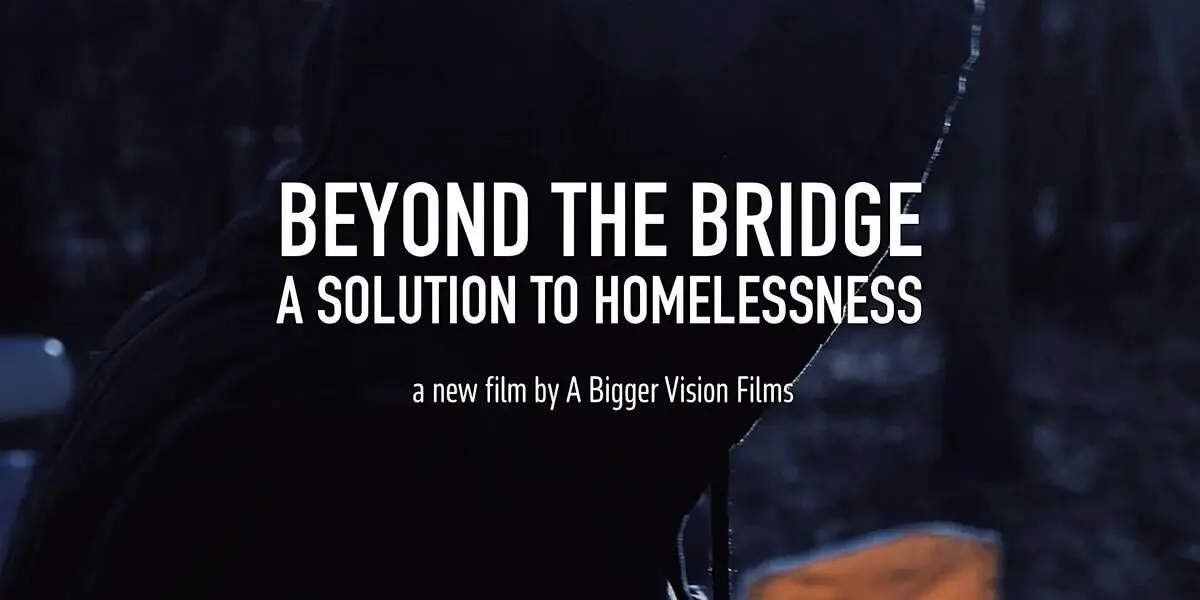Philadelphia residents Eric Tars and Andrew Spiers want you to see a movie with them. They’d like you – and as many of your friends, coworkers, and relatives as you can bring – to meet them Thursday at the Philadelphia Film center around 6 p.m. They’re asking you to get there a little early, the show starts at 6:30 sharp. You won’t need any cash, the filmmakers and their local partners – including Tars and Spiers – are treating you to the show.
Tars, Senior Policy Director for the National Homelessness Law Center (NHLC), and Spiers, a Bucks County native who has worked to battle homelessness in Philadelphia – first at Pathways to Housing and now as Senior Program Manager at CSH, the Source for Housing Solutions, both sit on an advisory board supporting a local impact campaign built around the screening of a new documentary, Beyond the Bridge, a Solution to Homelessness.
The film’s creative team, Don Sawyer and Tim Hashko, are excited to meet you, as well. They’d like to share what they learned while traveling the country in search of answers to the nation’s housing shortage. Neither of them has a background in homelessness, which makes what they learned about eliminating this pestilence even more revealing.
When the film opens, the pair welcome you into their vehicle – they named her Thelma – and become your traveling companions. They escort you across the U.S. on their journey of discovery. Together, you and the documentarians learn about chronic homelessness and consequently marvel at the communities that have managed to come to terms with the problem.
Before you go, let’s pack some background information for your trip.
The U.S. Department of Housing and Urban Development (HUD) is the lead federal agency dealing with chronic homelessness. It’s important to understand that Beyond the Bridge, a Solution to Homelessness deals with adults who fit the criteria laid out by HUD’s chronic distinction.
The U.S. Department of Education which handles the education of homeless children and youth deal with wildly different criteria and enormous numbers – millions of kids – 46,714 in Pennsylvania alone. Perhaps Sawyer and Hashko will make a film to tackle that nightmare some other time. For this Thursday’s film purposes, just think adults living under overpasses, in shelters and on the street.
A few years after its founding– during the Lyndon Johnson Administration – HUD became a cabinet level position, eventually assuming the task of building publicly owned accommodations as well as providing housing subsidies for low-income individuals and families. Since then, HUD’s funding and function have been turbulent.
Off to a good start in the 1970s, the final decades of the 20th Century were marked by divestment as various administrations limited or drastically reduced funding for housing. Eventually, in 1998, Congress passed the Faircloth Amendment, tying the hands of future lawmakers and prohibiting future expansion of publicly owned low wage, workforce, and elderly housing. The amendment capped all public housing at 1998 levels, regardless of the economy or population growth.
READ: Bucks County’s Valley Youth House Offers Shelter and Care to Our Most Vulnerable: Homeless Children
Then the George W. Bush administration further decimated subsidized housing by trading tax cuts to the wealthy for $1.8 billion worth of cuts in the nation’s rental assistance programs.
Remember those kids you’re supposed to forget about? Well, 43 percent of section 8 housing goes to families with dependent children in them. Again, not the topic of the film but their existence uses up a plurality of the limited housing available through HUD.
One last piece of information for your travel bag before you join Hashko and Sawyer on the trip. The National Low Income Housing Coalition announced that in 2012 chronic homelessness fell by a whopping 6.8 percent. “What?” You ask. “How could this be after all the cuts?” Easy. HUD changed the definition.
The fluctuation in the number of HUD defined chronically homeless is more the result of increased ineligibility. Prior to December 2011, an individual who experienced four or more episodes of homelessness in three years was considered chronically homeless. With the passage of the HEARTH Act, that only applied to people with a clinical diagnosis.
Anyone else living on the street had to prove that they’ve lived unhoused every night – consecutively – for an entire year. Proving a negative, that one doesn’t have a home, and didn’t sleep on their brother-in-law’s couch for a month, can be nearly impossible for many individuals experiencing chronic homelessness.
This explains – to a large degree – why in every state in the nation, desperate individuals sleep outside, without proper hygiene, privacy or protection.
And the long-term impact of that homelessness yields negative health outcomes – shortening life expectancies by decades. It also contributes to the ramshackle appearance of the nation’s most visible unhoused population.
Chris Kapp, one of Pennsylvania’s five eastern Continuums of Care, coordinated-entry regional managers explained, “The filth and desperation that hang on individuals who spend months, or years, on the street also makes them easier for the hard-hearted or unaware to fear, or even despise.”
Spiers concluded, “As homelessness has grown, frustration has grown.” And communities like Grants Pass, Oregon, have taken that frustration all the way to the U.S. Supreme Court – where, this past June, the municipality won the right to punish homelessness.
READ: Homelessness in Bucks County: Right Under Our Noses
Because of this, the NHLC’s Tars says, “This film couldn’t come at a more important time. For community leaders who don’t want to criminalize homelessness, this film is the key.” Tars, Spiers and the others on the local Beyond the Bridge steering committee hope that members of the general public attend for the same reason. “People aren’t asking leaders to criminalize homelessness. They’re asking them to address the problem.”
On Thursday night, Hashko and Sawyer will take you face-to-face with that problem. You will meet the chronically homeless, where the filmmakers did – where they live. By releasing the film gradually, city by city – Philadelphia is the 20th location, with requests in from 110 more – the men have created a tool that brings agencies, law makers, local business professionals and community members together to hear first-hand what it’s like to need a home and how communities can make that happen.
Spoiler alert – it can be done.
Tars and Spiers hope you’ll take them up on their invitation. Tars smiled as he explained, “The way Don and Tim tell the story, the story tells itself. My hope is that this film represents the problem in a way that resonates with elected officials; resonates with advocates, resonates with business leaders; and resonates with communities.”
Spiers added, “I want more people to see the film and be moved to action by it.”







